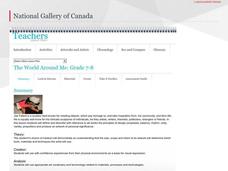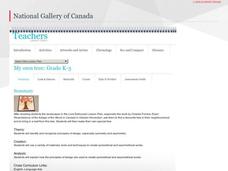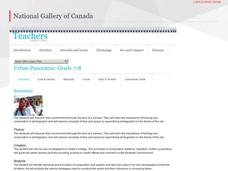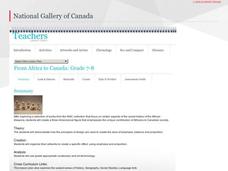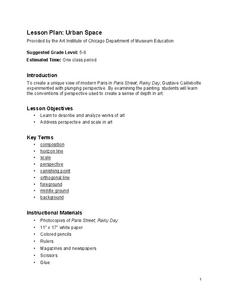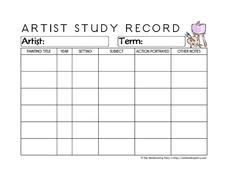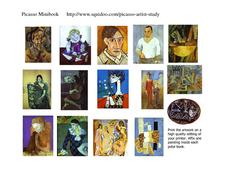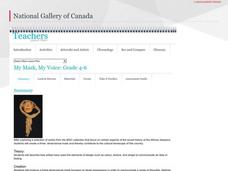National Gallery of Canada
Picture This!
Introduce your class to Inuit prints and use these artworks as inspiration for a printmaking activity. Pupils make stories to go along with the images and then come up with their own heroic moments to illustrate. They take moments from...
National Gallery of Art
Impressive Prints
Explore printmaking with a discussion and project. Pupils first view and talk about various examples of prints and cover positive and negative space. They then come up with fictional animals and make prints of their creature using...
National Gallery of Canada
Who Are You?
What can a self-portrait reveal about an artist? Discuss various self-portraits before tasking your pupils with creating their own. Learners research artists, develop an idea of their own individuality, and create photo collages with...
Missoula Art Museum
Dance with Your Fingers, Draw with Your Toes
Pair dancing, music, and art into one elementary lesson. Using the work of Henri Matisse and Rudy Autio as inspiration, kids spend a few days listening to music that fits the moods of various pieces of art, then work on their own...
National Gallery of Canada
My Upside-Down World!
M.C. Escher is famous for creating optical illusions. Examine this effect in several of his works and discuss the techniques involved. Inspired by the discussion, learners create an imaginary 3-D world inside of a box using various...
National Gallery of Canada
The Ideal Trophy
Invite your pupils to represent a club, team or other group with a trophy of their own creation. Learners examine the Taylor Cup by Laurent Amiot and then prepare trophy designs. When the sketches are complete, pupils sculpt...
National Gallery of Canada
Lumps, Bumps, Gritty, and Soft!
Texture can really add to a work of art. Explore texture through observation and practice. Learners view and discuss works of art by M.C. Escher. They then create their own texture samplers with six different materials.
National Gallery of Canada
The World Around Me
Have your learners use their surroundings as inspiration for an art project. Class members first examine and discuss art. They then choose an area and spend five days taking down observations in written and sketch form. These...
National Gallery of Canada
Make a Pinhole Camera
Introduce your class to photography by asking them to construct their own pinhole cameras. After putting together their own devices, pupils take and develop pictures and analyze the results. The plan provides step-by-step instructions...
National Gallery of Canada
Panoramic Landscapes
Combine landscape with collage to create unique art pieces. Class members examine works of art before creating their own pieces with photos of a special place. Learners create a panoramic image and add in figures.
National Gallery of Canada
My Own Tree
Nature contains both symmetry and asymmetry. Have your young artists examine symmetry and asymmetry in their own surroundings. After viewing works of art, pupils find trees in their neighborhoods and determine if they...
National Gallery of Canada
Urban Panorama
How can a photographer use images to represent a topic? Over the course of three days, learners discuss various photographs and practice their picture-taking skills with an outdoor, panoramic photography session. They use the images...
National Gallery of Canada
From Africa to Canada
Represent the African diaspora with figurines. Using a discussion on the contributions of people of African descent as inspiration, class members prepare sketches of a figure and put together a small sculpture from those sketches.
Oglebay Institute
Post-Impressionism: Van Gogh Drawings
Turn your young artists into little Vincent van Goghs with a lesson on brush stroke style and color blending. Pupils practice the painting technique by sketching various shapes before recreating a van Gogh piece or creating an original...
Art Institute of Chicago
Urban Space
The use of perspective is clear in Paris Street; Rainy Day by Gustave Caillebotte. Pupils study and discuss this example, marking the vanishing points and horizon line of a photocopy of the piece. They then create their own urban scene...
Curated OER
Lovely Ladybugs
Make cute ladybugs with egg cartons and pipe cleaners! After you read some facts about ladybugs, use different materials to make some ladybugs for your classroom.
Art Institute of Chicago
Color Combinations
Explore color through an examination of pointillism and light. Class members view Georges Seraut's famous painting on a computer, zooming in and out to see the details and effects of the technique. They then cover how light and color are...
Curated OER
Artist Study Record
What pieces of art have your learners studied so far? You'd certainly know if they had been using a record sheet! Each record page is reserved for one artist, and pupils can write in painting names and related...
Curated OER
Picasso Minibook
Display knowledge about Pablo Picasso and his works with a folder book. Learners cut out images, paste them into tiny petal books, and then attach those onto folder pages. In the additional space, pupils write about the words of art.
National Gallery of Canada
My Mask, My Voice
Recognize Black History Month with an examination of the African diaspora and a hands-on mask-making project. Learners first view and discuss images of artwork before creating their own plaster masks.
National Gallery of Canada
Self-Portrait, Mirrors and Metamorphosis!
Using M.C. Escher's Hand with Reflecting Sphere as inspiration, learners create their own set of self-portraits using various reflective surfaces. The lesson plan begins with a discussion about portraiture and ends with a presentation of...
National Gallery of Canada
The Roots of My Family
Represent family history visually by requiring your young artists to create family trees that express balance and symmetry. Pupils examine works of art, research their family histories, and put together large family tree posters.
National Gallery of Canada
Artful Emotions
Blue is sad, and red is angry, but why is that? Young artists explore the expression of emotions through art by observing and creating artwork. Starting with a questioning session about images of art, this plan moves into a sculpture...
National Gallery of Canada
Surprising Sun Prints
Here comes the sun! Composition, shapes, and the properties of light are the focus of this bright lesson. Class members examine art and then create sun prints using photosensitive paper and various objects of different shapes and sizes....









